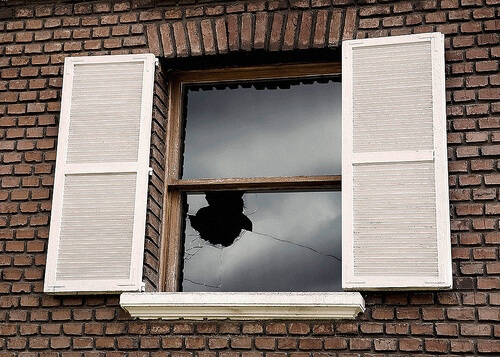Have You Heard of the Broken Window Theory?

Imagine that you’re walking down the street eating oranges, and when you’re finished, you have a ton of peels that you want to throw away. You realize that the trash can is far away, so your eyes move to the ground. If you see more trash there, the probability that you’ll throw yours on the ground increases, but if there is none, you’ll probably think twice before throwing your peels on the ground. According to the broken window theory, anyway.
The broken window theory, also known as the broken glass theory, predicts that deterioration in one’s surroundings can lead people to think that the law doesn’t exist. Therefore, in a situation where there are no norms, vandalism is more likely to occur.
The broken window experiement
Professor Phillip Zimbardo, known for the famous Stanford prison experiment, which led to books and movies on the subject, performed another celebrated but lesser known experiment. In this one, two abandoned cars were left outside, one in a neighborhood located in a poor and troubled area, and the other in a rich and peaceful area.
The result wasn’t too hard to confirm. Within a few hours, the car that was in the poor area already showed considerable damage, while the one in the rich area remained intact. With these results, it’s easy to conclude that poverty and marginalization were “responsible” for the crime.

However, the study still wasn’t completely over. After a week, the car in the poor neighborhood was completely destroyed, while the car in the rich neighborhood was still without a scratch. The researchers decided to change something about the situation and broke one of the windows of the car that was in otherwise perfect condition. What do you think happened? Robbery, violence, and vandalism reduced the vehicle to the same state as the one in the poor neighborhood.
In the end, they concluded that the cause wasn’t poverty, but that a broken window on an abandoned car sends a message of deterioration, apathy, and lack of concern. This in turn creates a sense that there is an absence of laws, norms, and rules. The broken glass made it seem like anything goes. In that situation, every attack that the car suffered reaffirmed and propagated that idea until the vandalism became uncontrollable.
Broken windows in the city
In the 80s, the New York subway was the most dangerous part of the city. Using the broken window theory as a reference, they started to fix the damages in the subway stations. They were cleaned up, the graffiti was painted over, and they cracked down on petty theft and made sure that everyone paid. As a result, the subway became a safe place.
Because of these results, a zero tolerance policy was instated in New York. Breaking any type of laws and lifestyle norms was prohibited, and cleanliness and order was promoted in the communities. Once again, the result was a huge decrease in crime rates in New York City.

Evidence of broken windows
The confusion created by unclear norms means that windows will continue to be broken, creating the same situation as in the car experiment. This can happen in organizations when the flexibility that they provide becomes too lax. If there was a broken window in a building that nobody repaired, soon other windows would suffer the same fate. If a community shows signs of disrepair and nobody cares about it, this could lead to more crime in the community.
Small problems can lead to huge transgressions that in turn lead to chaos. This doesn’t just happen with material things; another clear example is corruption. If small transgressions are allowed, more and more people will do the same thing more frequently. Establishing clear norms and exceptions can be a solution, as long as it doesn’t happen too late.
This text is provided for informational purposes only and does not replace consultation with a professional. If in doubt, consult your specialist.








